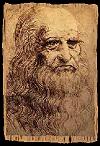|
Leonardo devised many vehicles, both for land and water, for convenience, and use in war. One of his most interesting designs was for a horseless carriage. This was a very basic system involving a platform on wheels, the front ones being articulated, and a number of coiled springs which drove a set of gears. As each spring was released the driver was required to wind up another one, thus providing (semi) continuous propulsion for his vehicle. But like many of Leonardo's flying machines, the demands on the operator didn't just stop there. He also needed to steer the 'car' using a small rudder-wheel.
Leonardo's drawings for this machine are sketchy when it comes to the spring system and it is thought he could not find a way to overcome the problem of connecting the springs to the wheels. He did make clear depictions of the transmission and this contains a differential which enabled each wheel to turn at a slightly different speed when corning. Many early motor cars lacked this important detail so it is fascinating to see it in Leonardo's design. Other wheeled devices developed by Leonardo measured distance (hodometers). Each time the wheel completed a revolution a pebble would drop down to a box. The number if pebbles provided the measurement of distance. He later improved this by using a gearing system that meant a pebble would drop only once each mile. This led to a pedometer which could be used on either man or horse and measured the number of steps taken using a pendulum which rested on the thigh. The bicycle was discovered during the restoration of the Codex Atlanticus. Found on the back of one of the pages, some people originally attributed to Leonardo, however there is now considerable doubt about this. In design it was very similar to our modern bicycles, having handlebars, pedals, and using chain drive. The designer envisaged it as being made from wood. A weak point in the design is the steering system which looks awkward and impractical. It is now considered likely that this drawing was done by a student of Leonardo's, as were a number of other newly recovered pieces found during the restoration, Perhaps the student had seen a similar item in Leonardo's studio or drawn by the master himself. But the bicycle may be even more recent than this. During the 1960's Codex Atlanticus was entrusted to a group of monks for examination and restoration. In 1974, the leader of the group announced the discovery of the bicycle among some glued and folded sheets of paper. This
was contradicted by an art historian who had looked at the same
papers in 1961. He had not unglued the sheets, but had examined
them under bright lights. His conclusion was there were two
unconnected circles between the sheets, and that was all. Confirmation
of whether or not the bicycle is a hoax would require expert
analysis, and these sheets have already been coated in a protective
plastic to prevent further deterioration. |
|

